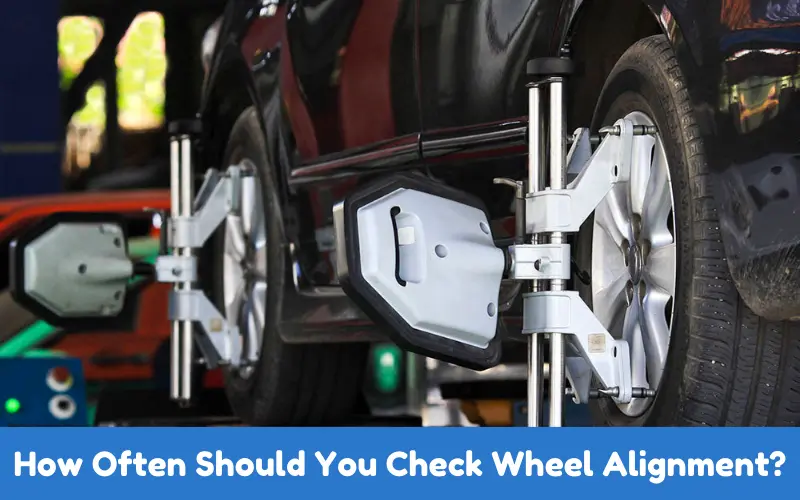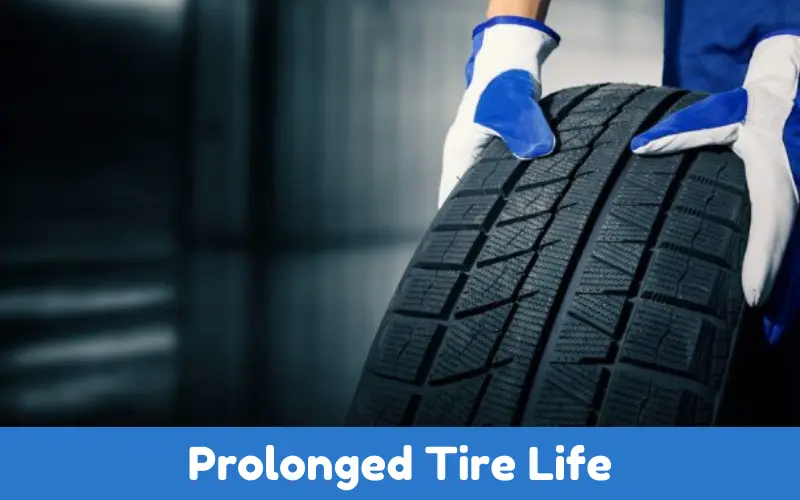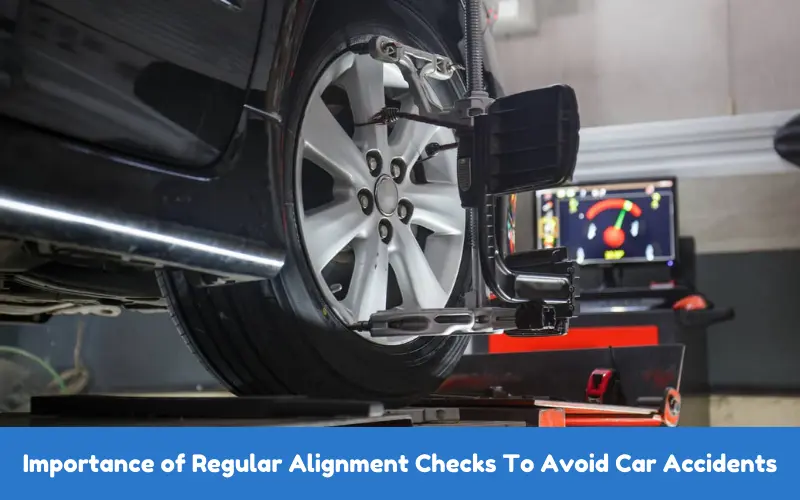Those who take to the road always try to examine the obvious car maintenance parts, such as the engine, the brakes, and the tires.
However, regular alignment checks, a sneaky culprit of car safety that goes largely unnoticed, are more crucial in preventing accidents than many realize.
When a set of wheels is misaligned, it compromises your ability to control the vehicle, especially in an emergency.
If you haven’t checked your wheel alignment in a while, the chances of you being in an accident rise significantly.
In this post, we will discuss why maintaining proper alignment for your wheels is essential for car safety and what is likely to happen should you ignore it.
Article Summary
What Is Wheel Alignment?
I’ve always found wheel alignment to be a particularly evocative expression of the word ‘alignment.’
Wheel alignment is the adjustment of the angles of the wheels so that they are within the manufacturer’s specified ranges.
These angles affect how the tires make contact with the road. Your wheels can get misaligned after hitting a curb or driving over a pothole, for example, or just from normal wear.
When your wheels are misaligned, your car may pull to one side or vibrate or bounce while you’re driving, making it harder to control.
Adjusting alignment ensures that the car’s wheels are at a right angle to the road and parallel to one another. The three critical angles that are checked during an alignment are:
- Camber: An angle either inward or outward, as viewed from the front face of the vehicle.
- Toe: The direction the tires are pointed in comparison to each other.
- Caster: The angle of the steering pivot as viewed from the side of the vehicle.
They affect the car’s performance, particularly its safety, according to each angle.
How Misalignment Contributes To Car Accidents
1. Decreased Steering Control
When your car’s wheels aren’t properly aligned, you can all too readily experience for yourself how this makes any steering more difficult, especially at high speed.
You might find that the car pulls you in any particular direction, demanding extra attention as if your steering wheel requires regular corrections to keep the car straight.
In an emergency, say if there’s an obstacle you need to slam on the brakes and avoid, then you’re likely unable to choose your course as well as you otherwise would, thereby raising the likelihood of a crash.

Poor alignment of a motor vehicle might also produce vibrations in the steering wheel, and this unnecessary vibration can result in failing attention.
Even a small deviation from the optimum vehicle handling might increase the probability of car accidents, especially if the driving condition is bad, such as during the rainy season or rush hours.
2. Uneven Tire Wear
Misaligned wheels can cause one or more of the four tires to wear faster on one side than the other.
If the car’s tires are poorly worn, traction will be reduced, affecting the braking performance. Reduced grip can lead to accidents, the fewer miles of rubber on the road, the longer a car will take to stop, especially in an emergency.
This risk is even greater in bad weather, such as rain or snow. Driving on tires that are unevenly worn can cause the car to skid or even hydroplane.
It can lead to uneven tire wear, making tire blowouts more likely at highway speeds, again increasing the chance of an accident.
A blowout at highway speeds can lead to loss of control or death when the vehicle careens off the road.
3. Increased Stopping Distance
This is bad news: poor alignment makes steering harder and extends your vehicle’s braking distance at highway speeds.
The reason behind this is that when your car’s wheels are misaligned, one area of the tire will experience higher pressure than another, it won’t distribute the load evenly.
Instead of braking efficiently overall, some parts of your tires will slow down faster than others. When every second counts in an emergency, this can become hugely significant.
Add stop distance issues to a bad handling attribute, and you have a potentially lethal recipe.
Brake to avoid an accident and find out your alignment is off: it could be too late to stop in time.
4. Strain on Other Vehicle Components
A car that’s out of whack isn’t just increasing wear on a set of tires. It nearly always damages other important parts, such as the suspension system, the brakes, and perhaps even the engine.
If those systems are compromised due to the vehicle’s vehicle not being aligned properly, your overall safety will also be compromised.
You’re more likely to have something go wrong at a critical juncture when your Chevy is dealing with five times its normal load on a bad shoulder of the freeway.
For example, suppose the alignment of the springs and shock absorbers is wrong. In that case, this might result in uneven distribution of the vehicle’s weight on the tires, which might result in blowouts or even loss of control on the road and ultimately cost the driver a lot of money in expensive suspension repairs.
How Often Should You Check Wheel Alignment?
However, since any kind of damage to the wheels, like a slight bump with a curb or pothole, could throw your tire alignment off, whenever you believe your alignment might be off, it’s best to have your alignment checked.

How often should a car’s alignment be checked? To bring some random order to this important issue, here you go:
- Every 6,000 To 10,000 Miles: When you rotate your tires (every 5,000 to 8,000 miles) or do your other routine maintenance, check your alignment. If you seem to be driving in the pothole mines of south Texas every weekday morning on your way to work (you know who you are), you probably want to have your alignment checked more often.
- After Any Collision or Curb Impact: Even minor accidents or curb impacts can throw your wheels out of alignment. If your car is veering to one side or you have a crooked steering wheel or uneven tire wear, visit your service center for an inspection.
- Whenever You Notice Handling Issues: Whenever you feel or hear anything different about handling, get an alignment check immediately if your steering feels off or you have another funny noise from your tires. These are often the earliest indications of trouble.
The Benefits of Regular Alignment Checks
In addition to preventing accidents, there are several other benefits to regular alignment checks:
Better Fuel Efficiency: If your wheels are misaligned, it will increase the rolling resistance of your tires on the road, bringing about more strain on your engine.
As a result, your engine has to work harder to move forward, which translates to less mileage and more frequent gas tank filling.
The upside is that having your wheels aligned will offset your need for more frequent visits to the gas station and fuel your car more efficiently.
Prolonged Tire Life: Regular alignment checks help prevent uneven tread wear, keeping the tires for the longer run.
Tires can be quite costly, and replacing them after a short period can cause a major dent in your pocket.

When the alignment of the wheels is proper, it extends their life, and you avoid the huge expenditure on replacements.
Improved Driving Comfort: A car with a balanced set of wheels will drive more smoothly and make your journeys feel more comfortable.
For a start, you won’t have the continual fight needed to keep your car straight. Badly balanced wheels can also cause a car to jump or make excessive and unusual noises and squeaks as you drive.
Lower Maintenance Costs: Misaligned wheels severely strain several vehicle components, eventually leading to expensive repairs and replacements.
It is better to fix your car when it is under control to decrease the long term possibility of major mechanical failures.
You need to align your car’s wheels regularly to ensure it stays safe to drive, operates at its best, and survives for as long as possible.
When the wheels are out of alignment, your car will handle differently, and stopping distances will increase, all of which raise the possibility of an accident.
When your vehicle is aligned correctly, it will be easier to handle on the highway, in city traffic, and all weather.
Get your alignment done regularly and protect yourself, your passengers, and everyone else on the road who is sharing the ride with you.

